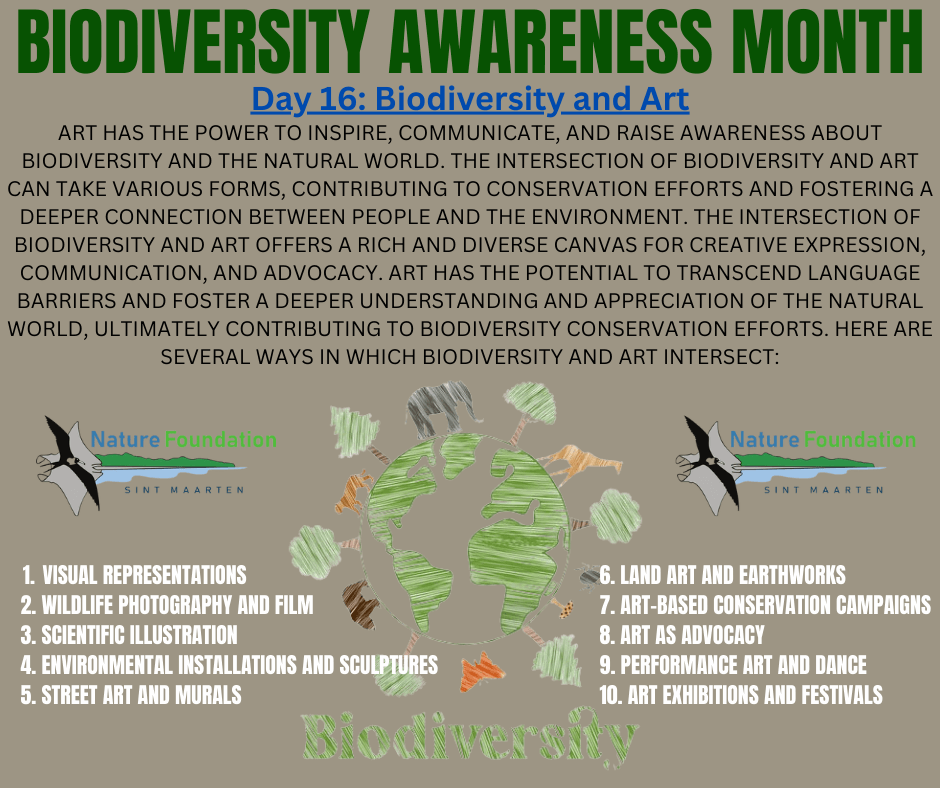Biodiversity month day 16: Biodiversity and Art
Art has the power to inspire, communicate, and raise awareness about biodiversity and the natural world.
The St. Maarten Hospitality & Trade Association supports the March Biodiversity awareness month organized by the Nature Foundation in an effort to help protect St. Maartens nature and biodiversity. Todays topic: Biodiversity and Art
The intersection of biodiversity and art can take various forms, contributing to conservation efforts and fostering a deeper connection between people and the environment. Here are several ways in which biodiversity and art intersect:
1. Visual Representations: Artists create visual representations of biodiversity through paintings, drawings, sculptures, and other visual arts. These artworks showcase the beauty and diversity of species, ecosystems, and landscapes, serving as a powerful tool for education and appreciation.
2. Wildlife Photography and Film: Photographers and filmmakers capture the essence of biodiversity through stunning images and documentaries. These visual mediums help convey the wonders of the natural world, promote conservation awareness, and provide a platform for storytelling about wildlife and ecosystems.
3. Scientific Illustration: Scientific illustrators play a crucial role in depicting accurate and detailed images of species for scientific publications, field guides, and educational materials. These illustrations contribute to the identification and understanding of biodiversity.
4. Environmental Installations and Sculptures: Environmental artists create installations and sculptures that engage with natural materials and reflect on ecological themes. These artworks may address issues such as habitat loss, climate change, or the interconnectedness of species within ecosystems.
5. Street Art and Murals: Street artists often use public spaces to create large-scale murals depicting local flora and fauna. These artworks contribute to urban biodiversity awareness, transforming cityscapes and encouraging people to connect with nature in unexpected places.
6. Land Art and Earthworks: Some artists use natural materials and landscapes to create temporary or permanent artworks. Land art and earthworks may highlight the beauty of the environment, draw attention to ecological issues, or reflect on the relationship between humans and nature.
7. Art-Based Conservation Campaigns: Conservation organizations and environmental activists often collaborate with artists to create campaigns that use art as a means of communication. Art-based campaigns can convey complex environmental messages in a visually impactful and emotionally resonant way.
8. Art as Advocacy: Artists may use their work as a form of advocacy, addressing environmental issues, promoting sustainable practices, and encouraging biodiversity conservation. Art has the potential to influence public opinion, policy decisions, and individual behavior.
9. Performance Art and Dance: Performance art and dance can be used to interpret and express the beauty and fragility of biodiversity. Choreographers and performers may draw inspiration from the natural world to create artistic representations that evoke emotions and connections with nature.
10. Art Exhibitions and Festivals: Biodiversity-themed art exhibitions and festivals provide platforms for artists to showcase their work and for the public to engage with biodiversity-related themes. These events can attract diverse audiences and facilitate conversations about conservation.
In summary, the intersection of biodiversity and art offers a rich and diverse canvas for creative expression, communication, and advocacy. Art has the potential to transcend language barriers and foster a deeper understanding and appreciation of the natural world, ultimately contributing to biodiversity conservation efforts.

